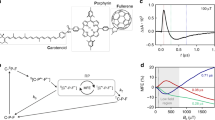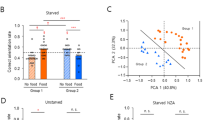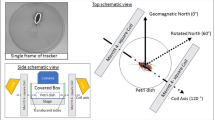Abstract
Approximately 50 species, including birds, mammals, reptiles, amphibians, fish, crustaceans and insects, are known to use the Earth’s magnetic field for orientation and navigation1. Birds in particular have been intensively studied, but the biophysical mechanisms that underlie the avian magnetic compass are still poorly understood. One proposal, based on magnetically sensitive free radical reactions2,3, is gaining support4,5,6,7,8,9,10,11 despite the fact that no chemical reaction in vitro has been shown to respond to magnetic fields as weak as the Earth’s (∼50 μT) or to be sensitive to the direction of such a field. Here we use spectroscopic observation of a carotenoid–porphyrin–fullerene model system to demonstrate that the lifetime of a photochemically formed radical pair is changed by application of ≤50 μT magnetic fields, and to measure the anisotropic chemical response that is essential for its operation as a chemical compass sensor. These experiments establish the feasibility of chemical magnetoreception and give insight into the structural and dynamic design features required for optimal detection of the direction of the Earth’s magnetic field.
This is a preview of subscription content, access via your institution
Access options
Subscribe to this journal
Receive 51 print issues and online access
$199.00 per year
only $3.90 per issue
Buy this article
- Purchase on Springer Link
- Instant access to full article PDF
Prices may be subject to local taxes which are calculated during checkout



Similar content being viewed by others
References
Johnsen, S. & Lohmann, K. J. The physics and neurobiology of magnetoreception. Nature Rev. Neurosci. 6, 703–712 (2005)
Schulten, K., Swenberg, C. E. & Weller, A. A biomagnetic sensory mechanism based on magnetic field modulated coherent electron spin motion. Z. Phys. Chem. NF111, 1–5 (1978)
Ritz, T., Adem, S. & Schulten, K. A model for photoreceptor-based magnetoreception in birds. Biophys. J. 78, 707–718 (2000)
Ritz, T., Thalau, P., Phillips, J. B., Wiltschko, R. & Wiltschko, W. Resonance effects indicate a radical-pair mechanism for avian magnetic compass. Nature 429, 177–180 (2004)
Möller, A., Sagasser, S., Wiltschko, W. & Schierwater, B. Retinal cryptochrome in a migratory passerine bird: A possible transducer for the avian magnetic compass. Naturwissenschaften 91, 585–588 (2004)
Mouritsen, H. et al. Cryptochromes and neuronal-activity markers colocalize in the retina of migratory birds during magnetic orientation. Proc. Natl Acad. Sci. USA 101, 14294–14299 (2004)
Weaver, J. C., Vaughan, T. E. & Astumian, R. D. Biological sensing of small field differences by magnetically sensitive chemical reactions. Nature 405, 707–709 (2000)
Cintolesi, F., Ritz, T., Kay, C. W. M., Timmel, C. R. & Hore, P. J. Anisotropic recombination of an immobilized photoinduced radical pair in a 50-μT magnetic field: A model avian photomagnetoreceptor. Chem. Phys. 294, 385–399 (2003)
Wang, K., Mattern, E. & Ritz, T. On the use of magnets to disrupt the physiological compass of birds. Phys. Biol. 3, 220–231 (2006)
Solov'yov, I. A., Chandler, D. E. & Schulten, K. Magnetic field effects in Arabidopsis thaliana cryptochrome-1. Biophys. J. 92, 2711–2726 (2007)
Ahmad, M., Galland, P., Ritz, T., Wiltschko, R. & Wiltschko, W. Magnetic intensity affects cryptochrome-dependent responses in Arabidopsis thaliana. Planta 225, 615–624 (2007)
Brocklehurst, B. Magnetic fields and radical reactions: Recent developments and their role in nature. Chem. Soc. Rev. 31, 301–311 (2002)
Timmel, C. R. & Henbest, K. B. A study of spin chemistry in weak magnetic fields. Phil. Trans. R. Soc. Lond. A 362, 2573–2589 (2004)
Wiltschko, W. & Wiltschko, R. Light-dependent magnetoreception in birds: The behaviour of European robins, Erithacus rubecula, under monochromatic light of various wavelengths and intensities. J. Exp. Biol. 204, 3295–3302 (2001)
Wiltschko, W. & Wiltschko, R. Magnetic compass of European robins. Science 176, 62–64 (1972)
Rodgers, C. T., Henbest, K. B., Kukura, P., Timmel, C. R. & Hore, P. J. Low-field optically detected EPR spectroscopy of transient photoinduced radical pairs. J. Phys. Chem. A 109, 5035–5041 (2005)
Thalau, P., Ritz, T., Stapput, K., Wiltschko, R. & Wiltschko, W. Magnetic compass orientation of migratory birds in the presence of a 1.315 MHz oscillating field. Naturwissenschaften 92, 86–90 (2005)
Kodis, G., Liddell, P. A., Moore, A. L., Moore, T. A. & Gust, D. Synthesis and photochemistry of a carotene-porphyrin-fullerene model photosynthetic reaction center. J. Phys. Org. Chem. 17, 724–734 (2004)
Kuciauskas, D., Liddell, P. A., Moore, A. L., Moore, T. A. & Gust, D. Magnetic switching of charge separation lifetimes in artificial photosynthetic reaction centers. J. Am. Chem. Soc. 120, 10880–10886 (1998)
Liddell, P. A. et al. Photoinduced charge separation and charge recombination to a triplet state in a carotene-porphyrin-fullerene triad. J. Am. Chem. Soc. 119, 1400–1405 (1997)
van Dijk, B., Carpenter, J. K. H., Hoff, A. J. & Hore, P. J. Magnetic field effects on the recombination kinetics of radical pairs. J. Phys. Chem. B 102, 464–472 (1998)
Timmel, C. R., Till, U., Brocklehurst, B., McLauchlan, K. A. & Hore, P. J. Effects of weak magnetic fields on free radical recombination reactions. Mol. Phys. 95, 71–89 (1998)
Rodgers, C. T., Norman, S. A., Henbest, K. B., Timmel, C. R. & Hore, P. J. Determination of radical re-encounter probability distributions from magnetic field effects on reaction yields. J. Am. Chem. Soc. 129, 6746–6755 (2007)
Poluektov, O. G., Paschenko, S. V., Utschig, L. M., Lakshmi, K. V. & Thurnauer, M. C. Bidirectional electron transfer in Photosystem I: Direct evidence from high-frequency time-resolved EPR spectroscopy. J. Am. Chem. Soc. 127, 11910–11911 (2005)
Efimova, O. E. & Hore, P. J. The role of exchange and dipolar interactions in the radical pair model of the avian magnetic compass. Biophys. J. 94, 1565–1574 (2008)
Weber, S. Light-driven enzymatic catalysis of DNA repair: A review of recent biophysical studies on photolyase. Biochim. Biophys. Acta 1707, 1–23 (2005)
Prabhakar, R., Siegbahn, P. E. M., Minaev, B. F. & Agren, H. Activation of triplet dioxygen by glucose oxidase: spin-orbit coupling in the superoxide ion. J. Phys. Chem. B 106, 3742–3750 (2002)
Henbest, K. B., Kukura, P., Rodgers, C. T., Hore, P. J. & Timmel, C. R. Radio frequency magnetic field effects on a radical recombination reaction: A diagnostic test for the radical pair mechanism. J. Am. Chem. Soc. 126, 8102–8103 (2004)
Buchachenko, A. L., Kouznetsov, D. A., Orlova, M. A. & Markarian, A. A. Magnetic isotope effect of magnesium in phosphoglycerate kinase phosphorylation. Proc. Natl Acad. Sci. USA 102, 10793–10796 (2005)
Acknowledgements
We thank M. Ahmad, D. Carbonera, M. di Valentin, G. Giacometti, C. W. M. Kay, P. Raynes, T. Ritz and R. Wiltschko for discussions; N. Baker for technical assistance; and the Oxford Supercomputing Centre for allocation of CPU time. P.J.H., C.R.T. and co-workers are funded by the Engineering and Physical Sciences Research Council, the Human Frontier Science Program, the EMF Biological Research Trust and the Royal Society. D.G. and co-workers are funded by the US National Science Foundation. I.K. is a Fellow by Examination at Magdalen College, Oxford.
Author Contributions K.M., K.B.H. and F.C. performed the experiments. K.M., K.B.H. and C.R.T analysed the data. P.A.L. and D.G. synthesized the triad molecule. C.T.R. and P.J.H. analysed the orientational averaging. I.K. performed ab initio calculations. F.C., C.R.T. and P.J.H. designed the study. C.R.T. co-ordinated the study. P.J.H. wrote the paper. All authors discussed the results and commented on the manuscript.
Author information
Authors and Affiliations
Corresponding authors
Supplementary information
Supplementary information
The file contains Supplementary Notes with Supplementary Figures S1-S3. (PDF 187 kb)
Rights and permissions
About this article
Cite this article
Maeda, K., Henbest, K., Cintolesi, F. et al. Chemical compass model of avian magnetoreception. Nature 453, 387–390 (2008). https://doi.org/10.1038/nature06834
Received:
Accepted:
Published:
Issue Date:
DOI: https://doi.org/10.1038/nature06834
This article is cited by
-
A framework for multiexcitonic logic
Nature Reviews Chemistry (2024)
-
General relationships between the kinetic characteristics of bulk and geminate recombination of radicals in solutions
Journal of Mathematical Chemistry (2024)
-
Insect magnetoreception: a Cry for mechanistic insights
Journal of Comparative Physiology A (2023)
-
Triplet Born Radical Pairs and the Low Field Effect
Applied Magnetic Resonance (2023)
-
Spin-selected electron transfer in liquid–solid contact electrification
Nature Communications (2022)
Comments
By submitting a comment you agree to abide by our Terms and Community Guidelines. If you find something abusive or that does not comply with our terms or guidelines please flag it as inappropriate.



